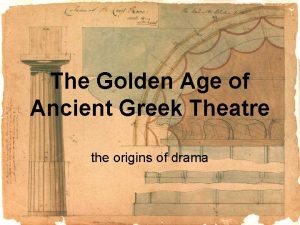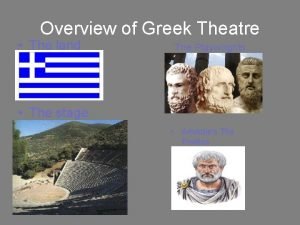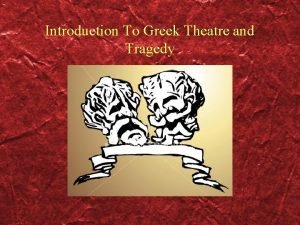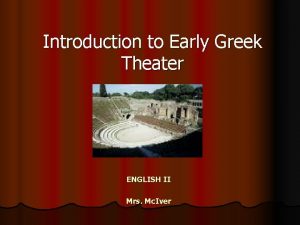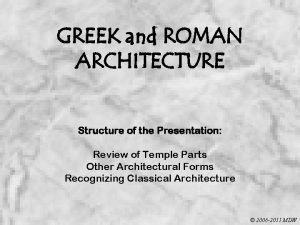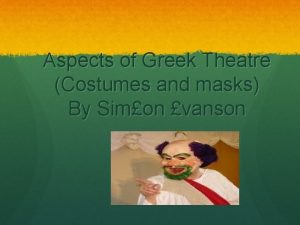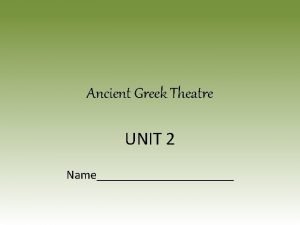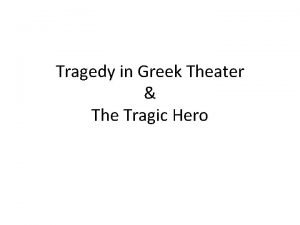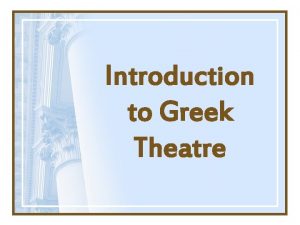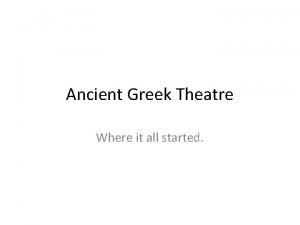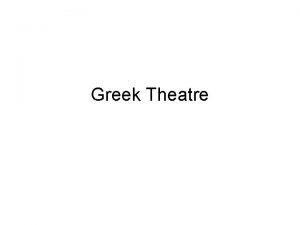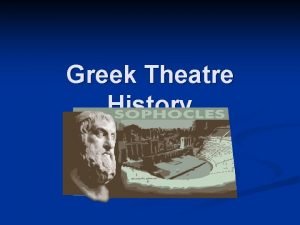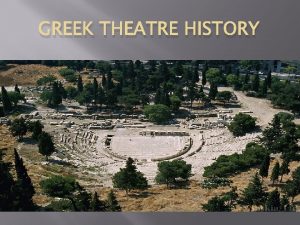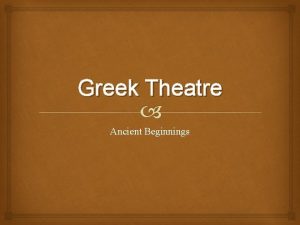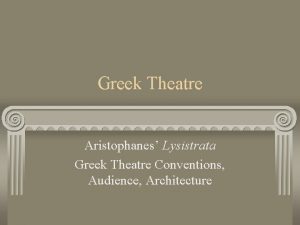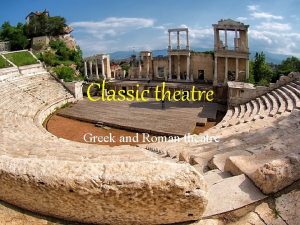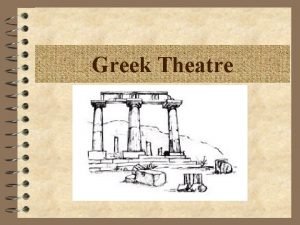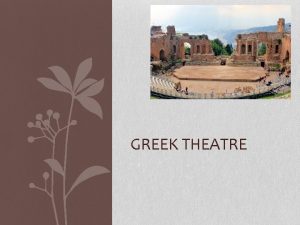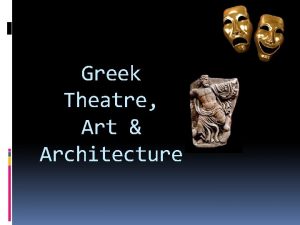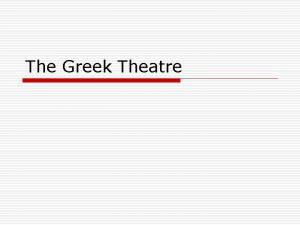History of the Greek Theatre The Theatre of
















- Slides: 16

History of the Greek Theatre

The Theatre of Ancient Greece Theatre in the Western World can be traced back to ancient Greece (c. 500 B. C. ) l Greek drama emphasized the attempts of human characters to control their own destinies. l

Dionysus Greek drama was presented exclusively at festivals honoring Dionysus. l Dionysus was the god of wine and fertility, his blessing was sought to ensure the fertility of human beings and the land. l

Festivals l By the 5 th century B. C. Athens held 4 festivals of Dionysus a year. l At three of these festivals theatrical performances were held. l The major festival was the City Dionysia. l City Dionysia was a religious and civic celebration where theatrical performances were given as offerings from the city to Dionysus.

First Theatrical Event 534 B. C. – first recorded theatrical event – a contest for best tragedy. l Thespis was the first winner. He is the earliest known playwright and actor. l The word “thespian, ” derived from his name, is still used to refer to actors today. l

City Dionysia Three dramatists competed at City Dionysia. l Each presented 3 tragedies followed by a satyr play. l The satyr play was short, comic and poked fun at Greek myths using a chorus of satyrs. l

Theatre of Dionysus l l The theatre is on the slope of the hill beneath the Athenian Acropolis. The slope of the hill served as the “theatron” (seeing space). A flat terrace below the slope served as the “orchestra” (dancing space). In the middle of the orchestra was placed a “thymele” (altar).

The Theatre of Dionysus l The slope was covered in a semi-circle with stadium-like stone seats. l It held 14, 000 -17, 000 people. l The orchestra was circular and 65 ft. in diameter. l The skene (hut or tent) was on the side of the orchestra opposite the audience.

The Skene l Skene is the origin of our word “scene. ” l Provided a place for actors to relax or to change costumes and masks. l The skene’s roof was also used as an acting area. l The “paradoi, ” or spaces between the skene and the auditorium were used for entrances and exits.

Conventions of Greek Theatre The action in Greek plays usually takes place in outdoors. l Plays were acted in daytime without lights or curtains l The Greeks had a religious and legal prohibition against showing acts of violence on stage, which meant that characters always died off stage. l Messengers would come in to tell audience what happened offstage l

Conventions of Greek Theatre l To increase dramatic intensity, the plays observed the “Three Unities” l 1. unity of time l 2. unity of place l 3. unity of subject

The Performers l 1. 2. 3. 4. The performers in Greek theatre can be divided into 4 categories: Actors Chorus Supernumeraries (non-speaking extras) Musicians

The Performers l By around 430 B. C. the rules of the contests restricted the number of speaking actors to three for each playwright. l This rule did not restrict the number of roles to three because a single actor could play several roles. l The same three actors appeared in each of the three tragedies.

The Chorus The tragic chorus was composed of 15 -20 men l A playwright had to apply to the principal government official for a chorus. l The choruses usually performed in unison, but sometimes as two subgroups that responded to each other. l

The Chorus l l l l l The chorus served several functions: 1. set the tone 2. give background info 3. recall events of the past 4. interpret and summarize events 5. ask questions 6. give opinions 7. give advice 8. stay objective 9. act like a jury of elders

Masks All of the performers, except musicians, wore masks. The masks served several purposes: 1. Facilitated rapid change of roles. 2. Made it easier for male actors to play female characters. 3. Helped the actor in assuming roles of different types.
 Ancient greek theatre history
Ancient greek theatre history Origin of greek drama
Origin of greek drama Greek theater terms
Greek theater terms Eccyclema greek theatre
Eccyclema greek theatre Ekkyklêma
Ekkyklêma Parts of ancient greek theater
Parts of ancient greek theater Greek theatre special effects
Greek theatre special effects Greek drama masks
Greek drama masks Structure of the greek theatre
Structure of the greek theatre Exodus greek theatre
Exodus greek theatre Greek tragedy costumes
Greek tragedy costumes Greek theatre stage labeled
Greek theatre stage labeled Ancient greek theater
Ancient greek theater Greek tragic hero
Greek tragic hero Greek theatre video
Greek theatre video Prohedria greek theatre definition
Prohedria greek theatre definition Skene definition theatre
Skene definition theatre



